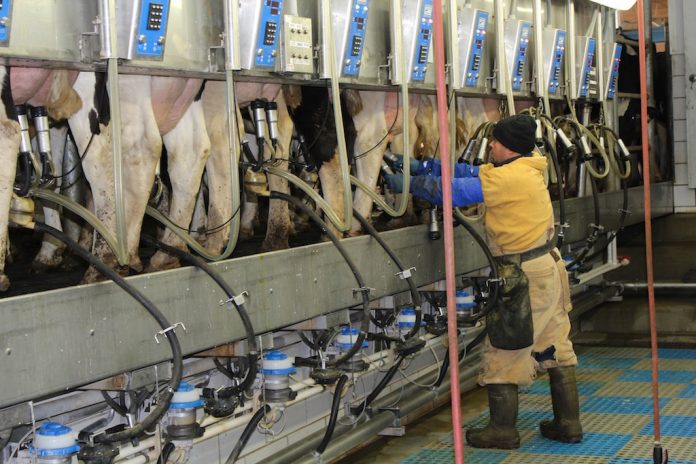SALEM, Ohio — Ohio livestock producers will face two new rules related to care and housing when the new year begins.
Effective Jan. 1, veal calves must be housed in group pens by 10 weeks of age, and at all ages must be able to turn around and not be tethered.
Secondly, dairy cattle can no longer have their tails docked, unless performed by a licensed veterinarian and medically necessary.
The rules were first approved in 2011 by the Ohio Livestock Care Standards Board, and later approved by the Ohio Legislature’s Joint Committee on Agency Rule Review.
Tail docking
Tony Forshey, state veterinarian, said tail docking was originally done as a way of improving sanitation, because the cow’s tail can become contaminated with manure and bacteria.
However, he said newer milking parlors and milking equipment, with their automated systems, have improved efficiency to the point where there’s less interference from swinging tails.
And in cases of medical concern, such as if a tail gets caught in a gate or stepped on, the tail can still be removed.
Forshey said dairy farmers can continue to trim the hair of their cows’ tails if they feel it’s necessary, and he added that there are machines available to make tail trimming more efficient.
Scott Higgins, executive director of Ohio Dairy Producers Association, said the marketplace had already decided the issue for the most part.
He said the major milk cooperatives stopped taking milk from dairies that used tail docking back in January, 2017.
“Many of our farmers who are marketing their milk through milk cooperatives are already discontinuing the process,” Higgins said.
Tom Thorbahn, executive director of the Ohio Holstein Association, said most purebred breeders do not practice tail docking. He said it could be an issue for some commercial dairies, but from the farmers he’s talked to there doesn’t seem to be much concern.
The American Veterinary Medical Association opposes tail docking, stating that “current scientific literature indicates that routine tail docking provides no benefit to the animal, and that tail docking can lead to distress during fly seasons.”
Veal rule
The rule on veal housing was the most contentious issue when it was being written, in 2010 and 2011, and will probably be the most contentious rule after Jan. 1. However, veal farmers say the rule’s impact has already been felt, and many still in business have made the required changes to their pens.
Jim Johnston, past president of the now defunct Ohio Veal Association, said farmers who are still raising veal have made the updates, but there are fewer veal farmers, especially at the independent grower level.
“I think the ones that are going to be operating are pretty well all changed over to loose housing,” he said. “But there’s been a lot of people who aren’t raising veal, compared to 10 years ago.”
Cost of production
Bob Cochrell, who was a member of the veal subcommittee that helped make recommendations to the care board, argued that the group pen system would be more harmful to the animals and more costly for independent farmers.
He stopped raising veal in 2013, in a move he said was indirectly related to the new housing rule.
Cochrell said the veal industry has seen a lot of consolidation over the past few years among feed companies and meatpackers. Demand for veal has declined, he said, and there’s been an increase in imports, making it harder for U.S. producers to compete.
Dean Mullet, president of Buckeye Veal Services, said his company barns were updated to group pens by 2009, about eight years ahead of the proposed date by the American Veal Association (2017).
“Our farmers have experienced a learning curve in transitioning to group house,” he said. “Raising calves in a group requires more attention and care.”
But Mullet said the economics are the same, and many cases better, than using the old tie-stall method.
However, the transition phase was costly and Mullet said that unlike Europe, the U.S. veal industry was not offered financial assistance. As a result, he estimates that about 50 percent of the U.S. veal producers have exited the industry.
Handling violations
Forshey said the goal with violators is to educate and bring them into compliance, but under the rules of the care board, a civil penalty of $500 to $1,000 can be levied for repeat violations.
He said a farmer in violation would first receive a letter of warning, addressing the issue and how it is to be corrected.
Approved by Ohio voters in 2009, the 13-member care board weighed public comment and research before forming rules that govern the housing and care of Ohio livestock.
Rules that have a major impact on the industry, and that require long-term planning, were given lengthier effective dates, to allow the industry to prepare. By the end of 2025, sows must be in group housing following the confirmation of pregnancy, essentially banning the long-term use of gestation stalls.













This is just one way Americans are allowing our country to be destroyed!! This has NEVER been about concern for animals!! It is all about CONTROL OF PEOPLE!! Take away the rights and freedoms of Americans and TELL them how to live-THAT is the COMMUNISTIC agenda to destroy America. Tell people how to raise their animals today…tomorrow control the way they bring up their children….People have become too STUPID to see the brainwashing that is happening and the destruction of our Constitution that these rules and regulations are doing. It is sickening and disgusting.
What happens to the young cows then if there is little veal industry?